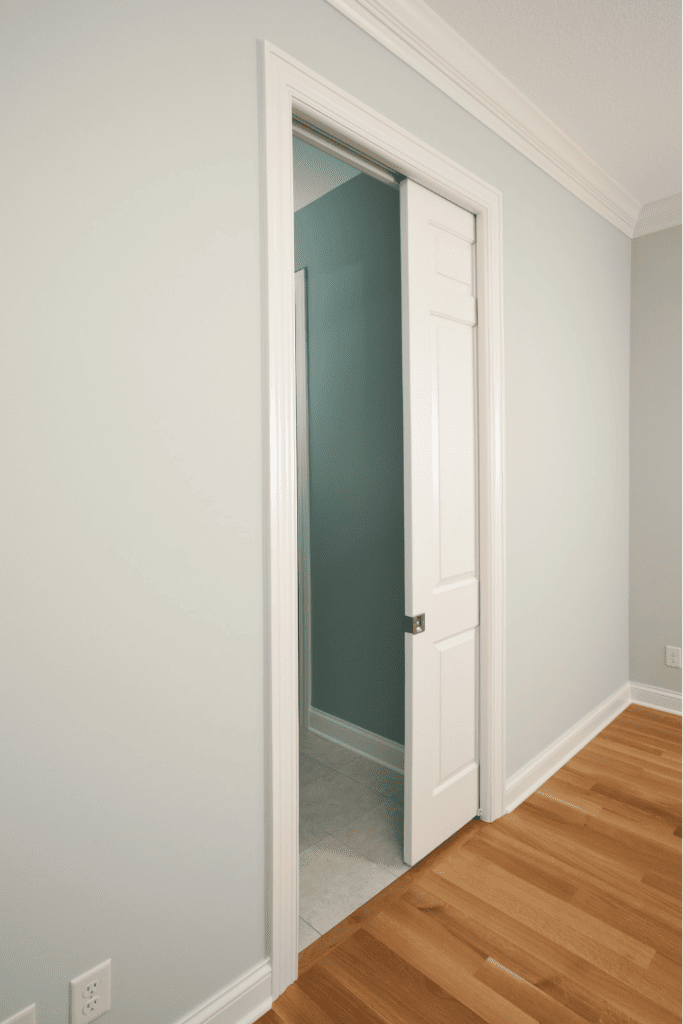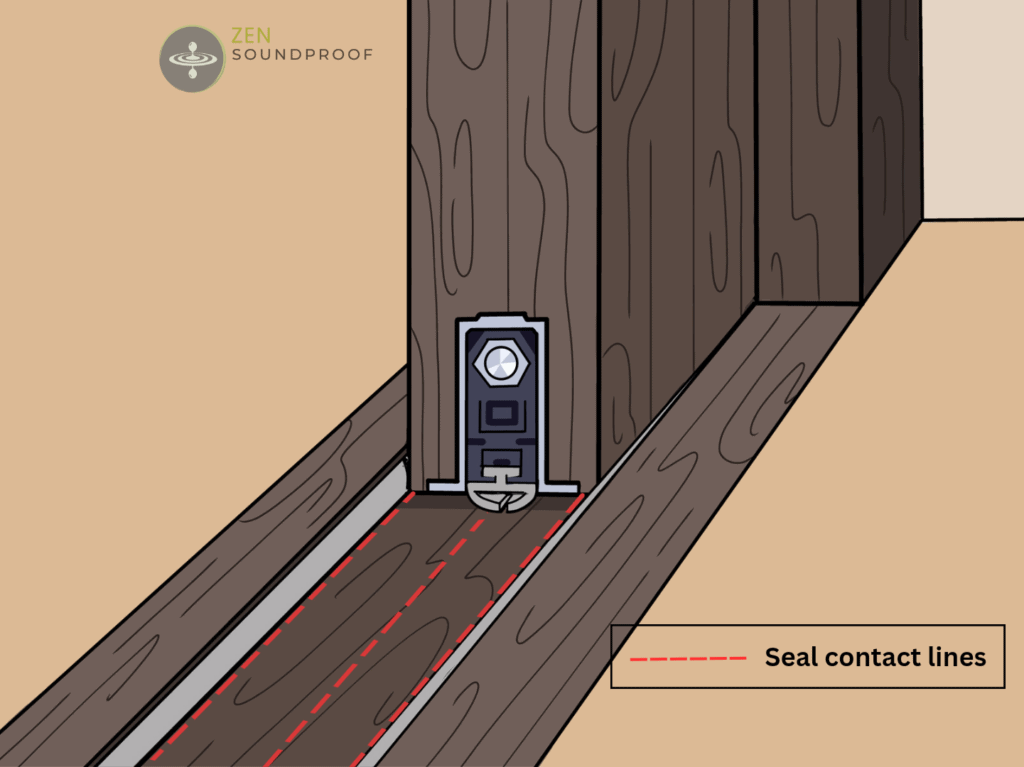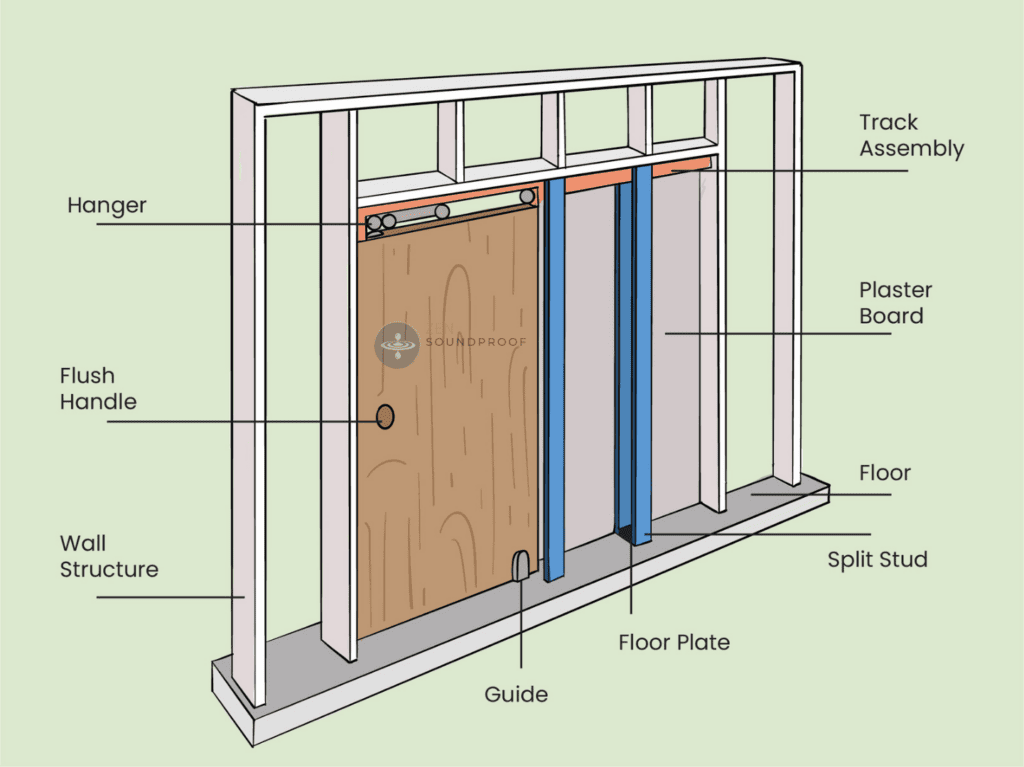A few years ago, a friend of mine moved into a home that featured pocket doors. I’d never really experienced them before, but as an engineer, I loved the practical design of them.
But one thing I didn’t love was the amount of noise they let through. My friend asked me if I had any tips to soundproof pocket doors so they could deal with this issue.
I did some research and came up with a few options. I’ve collected them in this article on how to soundproof pocket doors. So, if you’re dealing with the same problem, these tips should help!
Does A Pocket Door Block Sound?
Put simply, a pocket door won’t block sound. Doors are always one of the weakest areas for sound transmission, and the design of a pocket door makes this quite a bit worse.
You probably know how pocket doors work if you have them in your home. But to clarify, pocket doors are sliding doors that disappear into a hole in the wall (the pocket). The design can lead to sound leakage due to:
- The gaps around the door. Sliding doors don’t fit as tightly to the wall or frame as swing doors, resulting in more pathways for sound transmission.
- The material. Whether solid or hollow, pocket doors aren’t very thick. This means there isn’t much mass to block sound.
- The pocket. Depending on your home’s construction, the door’s pocket is likely an emptier gap than the rest of the wall cavity (assuming it’s insulated). This makes it easier for sound to pass through.
The bottom line is that pocket doors aren’t great for blocking sound. Equally, the design presents some unique soundproofing challenges. Specifically, there’s only so much we can do to block gaps otherwise the door won’t function properly!

7 Steps to Soundproof Pocket Doors
My solutions below take the unique design elements into consideration. I suggest reading through them and deciding which tips you can combine for your pocket doors. Also, don’t jump into this project expecting full soundproofing, as it’s impossible based on the door’s construction.
1. Add Mass to the Door or Replace the Existing Hardware
Making the door itself thicker or heavier will help block more sound. This works on the principle of Berger’s law. In short, this states that doubling a structure’s mass will reduce sound transmission by 6dB.
You have a few options for this:
- Replace a hollow door with a solid one
- Reinforce using MDF, OSB, plywood, etc.
- Covering it with soundproofing materials like mass loaded vinyl
However, you’ll need to bear in mind the following:
- Adding mass might mean you need to replace or reinforce the sliding track.
- Adding mass can increase the thickness of the door, which could prevent it from fitting into its pocket.
- Making the door heavier won’t address the gaps around it.
It’s still a good starting point for tackling noise transmission through the door itself to improve sound insulation.
Similarly, you could replace the door and pocket frame with sturdier and heavier hardware. This works on the same principles but looks a lot nicer. A good place to start is with a heavy-duty frame, such as the Johnson Hardware 1500.
Combined with a solid-core door, it should help to reduce noise transmission. A solid core door can have an STC (sound transmission class) rating of up to 35. This is much better than a hollow door, which typically has an STC rating of 25.
It might also be worth looking into an acoustic pocket door, such as those made by Eclisse Acoustic. However, acoustic doors of this nature are quite expensive and it’ll take a lot of installation to make an acoustic pocket door work.
2. Fill Gaps with Acoustic Caulk
Gaps between the door frame and wall are easy pathways for sound waves. Blocking them with acoustic caulk (such as Green Glue) prevents this from happening. I recommend watching this video on how to seal door gaps with caulk, and you should aim to seal the entire door frame.
Acoustic caulk is better than normal silicone sealant because it retains some flexibility. This helps dissipate sound waves but also means it won’t crack if there’s any more movement between the frame and the wall.
Of course, this won’t work for the gaps between the door and its tracks, or the door and the floor. For these, you’ll want to use the tips below.
3. Apply Foam Tape and Door Gaskets
Foam tape (also known as weatherstripping) is an effective way to seal gaps around sliding doors. Applying it to the door will help minimize the gap where the door meets the wall.
It’s potentially more effective on sliding doors that sit in front of the wall rather than pocket doors. The latter only connects with the wall on one side as opposed to three.
However, if you added a manual sealing mechanism (such as a hook or latch) that held the door tightly against the wall, weatherstripping would help.
For the bottom of the door, you’ll want to consider a gasket or door sweep. Something like this aluminum gasket and weatherstripping acoustic kit will help seal the gap. Of course, you’ll be limited in what you can fit because the door will still need to fit into its pocket. Addressing the upper and lower perimeter in this way is vital for filling the biggest gaps.
4. Block the Gap with Carpet or Rugs
Another option for sealing the gap at the bottom is to plug it with carpet or a rug. In my article on the best soundproof carpet padding, I explain how these materials help to reduce echo and provide some protection against impact sounds.
The more permanent option would be to lay thick carpet under the door so it’s harder to close. For a temporary solution, you could buy a small rug and scrunch it up and shove it in the gap when the door is shut.
Unless you find a really decent acoustic door gasket that fits in your door’s pocket, laying carpet will probably be a better solution. In short, it’d fill the gap with an absorptive material to reduce sound transmission slightly. Although not known for its mass, carpet will arguably add more to the gap than a metal gasket.
Also, it’s worth noting that pocket doors (much like barn doors) don’t have rails on the bottom. All their hardware is on the top of the door, meaning it should be fairly easy to fit carpet into the gap.
5. Install an Automatic Bottom Seal
You can probably spot a theme here. Addressing the door’s bottom gap is a primary focus because it’s often the biggest. With normal sliding doors, there are considerable gaps on each side. Pocket doors, on the other hand, typically only have a large gap at the bottom.
Automatic bottom seals (such as this one from Trademark Hardware) are spring-loaded rubber seals that drop into a fitted channel, which is activated when the door shuts. They’re a good alternative to sweeps because they create a pressure-based seal resulting in a tighter fit. However, they’re pretty pricey.

To an extent, they suffer from the same weaknesses as other gaskets and door sweeps. That said, an automatic seal like the one linked above should provide a decent reduction in sound transmission.
It consists of a sweep on each side and a sunken channel into which the seal drops. This means there’s a varied pathway of different materials, both of which are useful factors in stopping sound transmission.
6. Hang Soundproof Curtains
Soundproof curtains are a common go-to option for reducing sound transmission through doors. They’re one of the least obvious solutions because it’s not unreasonable to see a curtain hung in front of a door.
Soundproof curtains work by combining several layers of material to absorb sound waves and, to a lesser extent, offer some sound blocking. I have a full article on the best types of soundproof curtains, so check that out for more information.
They can also help by creating an air gap between the noise source and door. Combining this with different materials (fabric, felt, wood door, etc.) results in a more challenging transmission pathway for the sound waves. As such, they expend energy at different frequencies.
For best results, you’ll want your curtains to extend over the door onto the surrounding wall to address gaps around the door. However, don’t expect miracles from your curtains. They’re not heavy or dense enough to provide amazing sound blocking.
7. Fit Soundproof Blankets
An alternative to curtains that provides a bit more mass is an acoustic blanket. These work on the same principle but may also include sound-blocking materials. Again, I’ve got an article on the best acoustic blankets for soundproofing, so check that out.
I’ve separated the 2 products because their installation methods are slightly different, as are their densities and materials. Soundproof curtains are easy to install: you hang a curtain rail.
Acoustic blankets might be slightly harder. Some come with grommets, which you could hang from hooks. Others don’t, so you’d need to sew in loops so you could hang them from a rail.
An acoustic door panel is a similar option, except it’s rigid. While it can be added as a more permanent option, you’d run into the same issues as adding more mass.
Types of Pocket Doors and How They Affect Soundproofing
As mentioned, pocket doors differ in construction from normal sliding doors. Along with having a pocket fitted in the wall, they fit into the frame differently by only making contact with the wall in one place when closed.

Within the overall bracket of pocket doors, we have 4 types:
- Single pocket doors. The most common type, these are single doors that slide into a compartment hidden in the wall. They’re ideal for spaces where a swing door might not be practical.
- Double pocket doors. The same as single doors, except there’s two! They open from either side and meet in the middle, making them ideal for larger spaces or as room dividers.
- Telescopic pocket doors. These doors feature 2 or more panels that slide from the same side. However, you could have sets of 2 or more panels sliding from each side – the point is that there’s several panels that slide over each other.
- Glass pocket doors. Pretty self-explanatory: these are pocket doors with glass panels instead of wood. They’re often used in spaces where extra light is helpful (i.e., bathrooms or wardrobes) and can feature frosted glass for privacy reasons.
Challenges of Soundproofing Different Types of Pocket Doors
Other than single pocket doors, every type presents unique challenges when applying soundproofing solutions. Some examples include:
Double pocket doors and telescoping pocket doors will be difficult to reinforce or apply mass. The added depth from the extra materials could prevent them from sliding over one another or into the pocket. You also can’t use acoustic jambs because pocket doors don’t have the right setup for them.
Similarly, you’ll have an issue hanging acoustic blankets. These are more temporary than soundproof curtains and often narrower, meaning you’d need several. Also, you’ll need to cover both the pocket door and the door hole, which would require quite a few blankets.
As such, your best option would probably be soundproof curtains, although you’d need more than one to properly cover the doors and walls. Combined with sealing the bottom gap, you should notice some reduction in sound transmission.
Also, glass pocket doors are better treated like other sliding glass doors. I have an article on how to soundproof sliding glass doors, so read over that for some more specific tips.
The solutions I’ve given above are based on single pocket doors. However, you can adjust them as needed to fit the setup you’ve got.
I find that a combination of sealing gaps around the entire door perimeter and hanging something in front of the doors to create an air gap will limit unwanted noises. That said, the construction of a pocket door (specifically it fitting into the wall) means you can’t really use any materials with high sound-proof performances.
Final Thoughts
I hope this guide has given you some inspiration for how to soundproof pocket doors. Although challenging, there are some things you can do to reduce sound transmission.
In my experience, I find it’s best to combine as many solutions as possible, and to put together a plan before you start. Consider the weakest areas of the door’s construction and what options could solve each problem.
Do you have any other tips for reducing noise transmission through pocket doors? If so, I’d love to hear from you.
